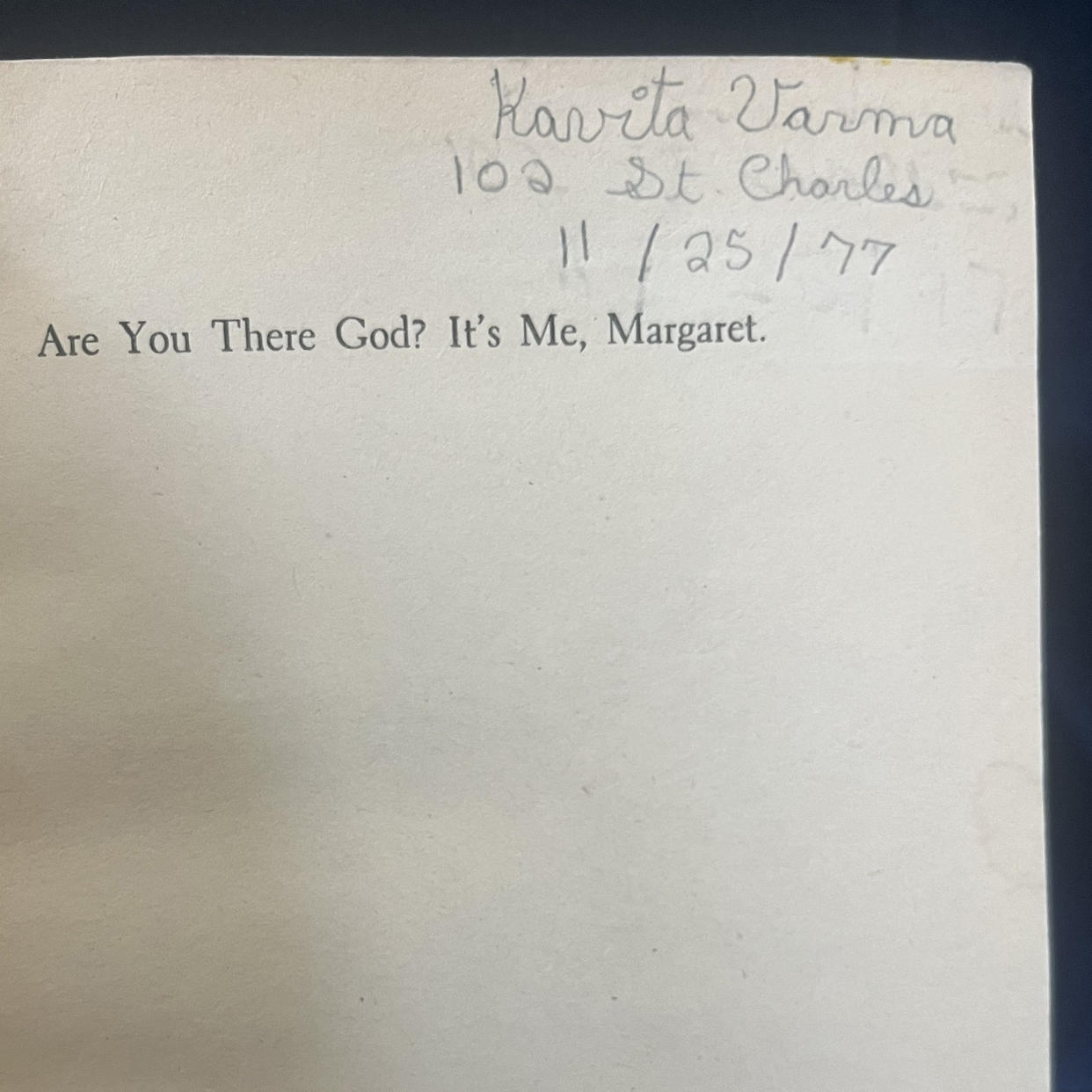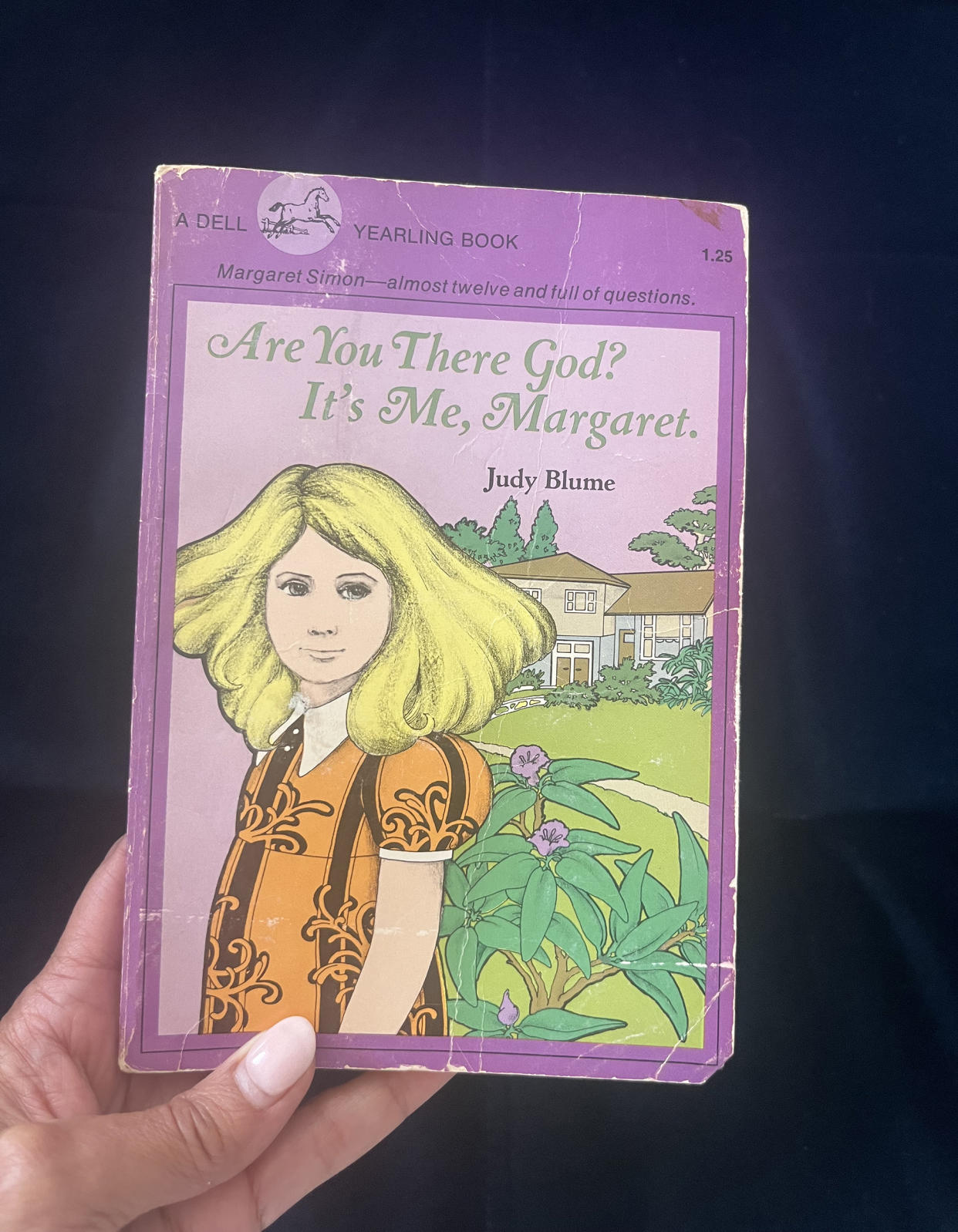What I learned from reading Judy Blume's 'Are You There God' again in my 50s
I can vividly remember being curled up in one of the cozy brown velour armchairs in our '70s grasscloth-wallpapered Oklahoma living room, nose deep into Judy Blume’s coming-of-age novel, “Are You There God? It’s Me Margaret.” My parents were in the adjoining kitchen, my mom likely stirring whatever Indian food she was making for the evening.
I got to a four-syllable word in the book that I could sound out but didn’t know the meaning of. So I yelled out to my dad for help.
“Daaad! What does 'men-stroo-a-shun' mean?”
My dad looked caught off guard and turned to my mother. “What is she reading?!”
That’s the extent of the memory I have. I don’t recall how my parents answered it, or if they answered it. I was 9. I wouldn’t get my period for another … several years! … so, understanding the definition of menstruation was not crucial to me at the time.
But Margaret Simon. Margaret’s character from the book lives on in my memory. With the upcoming film version coming out April 28, I recently re-read the now-iconic book — the SAME, worn, purple-covered copy that still has the name/address/date info my mom made me write in every book: Kavita Varma, 102 St. Charles, 11/25/77, in my early cursive writing. And I was delighted to find the story still captivated and resonated with me.

While the book made pre-pubescent me most definitely contemplate the pros and cons of maxi pads vs. tampons and “we must increase our bust” exercises (which, sadly, never worked), 50-something me had a different realization: Margaret may have unwittingly guided me through my own quasi-exploration of religious identity.
Margaret’s story is about how, after moving to a new city, she realized her parents’ interfaith marriage had left her without a religious affiliation. Her quandary revolved around belonging: Is she Christian, like her mom? Or Jewish, like her dad? Does she belong at the Y, with friends Nancy and Janie? Or at the Jewish Community Center with Gretchen? Her paternal grandma, Sylvia, takes her to synagogue to meet the rabbi. Her maternal grandparents want her to meet a minister. In personal, sometimes silent conversations, Margaret reaches out to the one expert who can help her sort things out: God.
Before my own mother worries while reading this, let me just state that I was born a Hindu, like both of my parents and the rest of my extended family, most of whom live in India. While growing up in America, I lived in a household where my family worshipped Hindu deities such as Lord Krishna, Lord Shiva and Lord Ganesha, and lit a “Nilavilakku” lamp during auspicious occasions. As a child, I learned prayers that I still say today. On our visits to India, I go to the Hindu temple attended by my aunts, uncles and cousins. My belief in my Hindu faith remains unwavering, and I find peace in it.

Still, in the small Oklahoma town where we lived, my family was, for the longest time, the only Hindu family in town. (There was also one Jewish family, our friends the Millers, who invited us to Passover Seder.) Everyone else we knew was Christian, from all persuasions: Baptists, Methodists, Presbyterians, Catholics and more.
All of my friends belonged to church communities that had thriving programming. Ever the social extrovert, I was always game to attend whatever I was invited to. And I was invited to it all: Youth groups, festivals, choir, vacation Bible school, church camp. I was equal-opportunity: If you were getting me out of the house on a Wednesday night or Sunday morning or a week in the summer, I didn’t care what denomination you were.
Given that I was a fairly regular presence, I was asked on many occasions — though never, ever pressured — if I was interested in joining fill-in-the-name parish or congregation. While there may have been a part of me that was subconsciously experimenting with different faiths, it was never for the right reason. Rather, it was simply about belonging — fitting in with the crowd — at Baptist church with Mary; at Methodist church with Nicole; at Catholic mass with DeAnn.
My parents did not love what they called my “gallivanting around town” to this-or-that church and, at the time, I didn’t realize how they must have felt threatened. It all came to a head when I was about 12 and came home from a Wednesday night at First Baptist Church to ask a very big question:
“Mom, can I go on the Baptist youth group ski trip?”
My mother got visibly upset and asked me in a serious tone, “Do you want to convert to Christianity?”
I was dumbfounded, because the thought had truly never entered my mind. Laughing, I told her: “What? I just want to go skiing.”
While the answer was a “no” to skiing, there was one good outcome. I think my parents realized that my church-hopping was recreational, just my way of trying to fit in with my friends. Much later, I came to realize that had I grown up in a place that had a Hindu temple community, like my Indian cousins had, I would not have felt the need to “try” something else.
Margaret’s story in “Are You There God?” ends before we discover what, if any, religion she chooses to follow. I can only hope that grown-up Margaret discovered that following a religion — and finding faith — means way more than “fitting in.” It means believing in something that brings you peace.
Re-reading one of my favorite childhood books as an adult reminded me of that.
This article was originally published on TODAY.com
